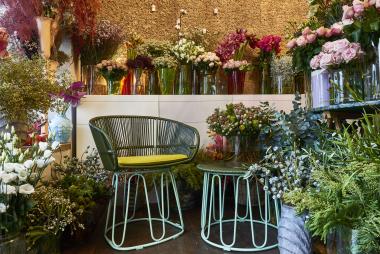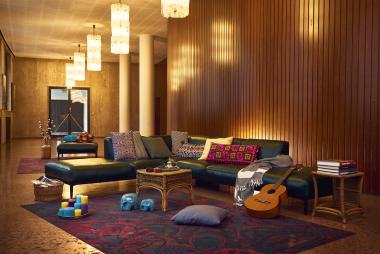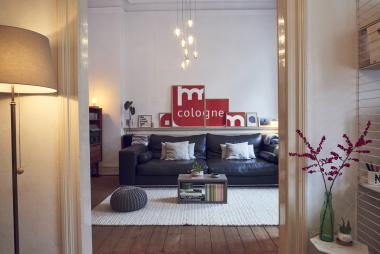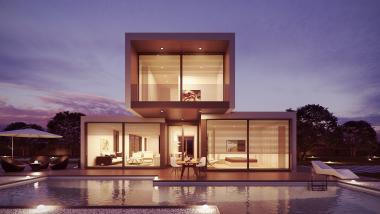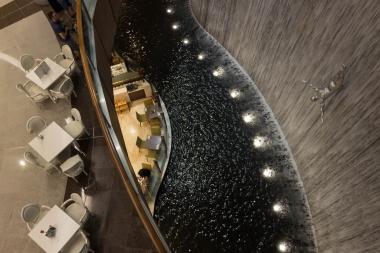IMM COLOGNE 2018: MEGATRENDS AND THE WAY WE LIVE
Megatrends are becoming increasingly visible in the way we live.
Be it globalisation, urbanisation, digitalisation, individualisation or neo-ecology: German and international manufacturers are keeping pace with the times and are offering more and more options in their range of furniture and fittings. Customer needs can no longer be deduced from socio-demographic characteristics and target groups alone - people's lifestyles are too different for that these days. The megatrends influence the directions in which the additional options develop: They drive things forward and point out new directions at the same time.
The megatrend of individualisation has intensified in the furniture sector on at least two levels: The catalogues are bursting with diverse options and the internet is the first port of call to get an idea of what's on offer. Several portals offer tailored advice or allow you to furnish your own home in a virtual reality setting.
The megatrend of digitalisation has also impacted on the way we live in two very clear ways. When it comes to the products themselves, the "smart home" is becoming increasingly important. Many household appliances, doors and windows, white goods and heating control systems now come with applications that improve comfort and convenience in everyday life. The second element has far-reaching effects on our mood. The honest ones among us will admit their overexposure to various media. Within a minute of waking, most people have their smartphone in hand as they start their day. The sensory overload immediately begins, if not with a smartphone then with the television or radio triggering constant distraction and a desire for a multitude of things. We lose ourselves in the face of so many options (the weather, the stock market, breaking news, emails, recipes, music). When the back of your mind wakes up too - and with that a torrent of terms such as digital transformation, chatbots, bitcoins, blockchain, dash buttons begins to flow - you suddenly feel an urgent need to get a grip on reality. Old favourites are making a come-back. Vinyl records, classic cars and filter coffee are all enjoying a boom. In home furnishing, models from the "good old days" are hugely popular: the vintage look, retro, boho-chic, mid-century design. In our fast-paced age, it comes as no surprise that many people in the developed world have fallen in love with this style of furnishing. In the virtual world, we are looking for something real, or at least something purportedly real … and Pantone declares ultra violet the Colour of the Year 2018. It is an old acquaintance: clerical power, feminism, extravagance, drama, creativity, "the last attempt", mystical and spiritual, both future-oriented and traditional, but a counterculture most certainly. Denmark has given the world the "Hygge" phenomenon, a countervailing measure that brings cosiness back into our homes.
Two-thirds of Germans want their home to exude cosiness. Most people find that easier to achieve with an organic design language, authentic materials and warm colours than with cool, angular and minimalist furniture designs. Colourful combinations of furniture, wall colours, wallpaper, decorations and accessories are also popular because they help express the desired feeling of individuality.
Good lighting is becoming ever more important for the overall atmosphere in the home. LED lighting technology is now cost-effective, and can be found in the glass display case, behind the shelf or under the bed, making an important contribution to the home's cosy lighting ambience. The lighting industry's latest highlight is improved LED light batteries with long run-times. These flexible, portable and cable-free light sources are very handy for small apartments. This kind of small lamp can be used as a functional light in the kitchen, as a reading lamp at the table and as indirect illumination when chatting in the evening. In former times, candles were carried around the home, today we carry cutting-edge LED battery lamps. Talking about candles, the consumption of real candles has been growing steadily over the last five years. According to the European Candle Association (eca), each EU citizen consumed an average of 1.45 kg of candles (+6.2%) in 2016, with further growth expected. Opulent, Baroque-like candlesticks are in fashion, and help to create cosy living spaces. Candlelight is highly prized. Indeed, we could speak in terms of a digitalisation by candlelight. There is a close link between living style and the longed-for attitude to life. In times like these, it is not surprising that more and more people divide their world in two. On the one hand, they have a "private shire", as Stephan Grünewald from the Rheingold Institute calls it, in which they feel snug and safe. Then they have an external "grey country", an often frightening world of terror, globalisation, food scandals, Brexit and capricious political leaders. The private sphere is often designed as an idyllic retreat to make it easier to filter out the external world. This idyll is the counter-world to the hard and digital reality. It's all about nest-building, comfort, security and cosiness - a means of escaping the often-overwhelming anonymity of the external world.
Before the backdrop of globalisation, the home becomes the central location of identity. Furnishing their homes in a personal way gives people a sense of belonging. Identity is a matter of self-creation, not only in terms of the personality but also of the private environment. We form our identity on a day-to-day basis through the way we live. Many people perceive the world as an excess, and they see their own home as an identity-forming protected zone. The home is guarded, fashioned and loved. Security technology and creativity are spreading and the home is becoming the only enclave of informality. Following the maxim "The world is too much for me, I'm enough for myself", the home is a retreat, a refuge and an idyllic world.
In the modern age, populations tend to move from rural areas to the cities. For the first time in history, more than half the world's population now live in urban conglomerations. Major cities face two challenges that have long been identified: The constant need to find more living space, and managing the growing volume of traffic. When it comes to the way we live, the megatrend of urbanisation becomes more concrete in a number of respects. There is already a growing longing for ruralisation among city dwellers, while - paradoxically - new digital innovations are making possible new ways of working and living, far away from the smoke and smog of the city. It is already possible to work without a fixed base in a number of occupations. In future, the toilet lid in the smart home will regularly test the urine for signs of disease, taking care of prevention and making medical care plannable. Villages could experience a renaissance when drones deliver shopping, and electric driverless cars take children to school.
In the season ahead we will see the introduction of more organic forms, especially in the seating furniture sector. Organic design takes its cue from organic nature. Dynamic curves and powerful cambers come to the fore as striking characteristics. Organic design is soft and is therefore distinct from geometric and functional shapes. A wide range of natural fibres is on offer as upholstery fabrics for padded furniture, with corduroy and velvet playing a prominent role.
The blue colour spectrum - from European blue and light blue to turquoise and petrol - remains popular. Blue represents harmony, imparts a sense of reliability, and has a pleasant calming effect. Olive green is the new trend colour, representing naturalness, spring, hope, health, youth, nature and vegetation. However, olive is not gaudy; the grey aspect in it makes it a quiet and inconspicuous choice.
Linoleum is making a come-back. The material was invented in 1860 and consists mainly of linseed oil, ground cork dust and jute fabric. It was originally intended for use as an elastic floor covering and it is still used in that way to this day. The furniture industry utilises linoleum as a tabletop surface, sideboard front and bureau inlay. It is a robust, green material that stands for healthy living.
Solid wood is about to strengthen its position further. The designs for tables, cupboards and sideboards are delicate and elegant, having moved away from the rustic look of the past. Oak remains the top seller, but walnut and cherry wood are maintaining their position. Wood combined with other natural materials such as glass and metal is also a popular choice for the visible parts of cabinets.
The visual quality of furniture in all price categories is generally improving. In future, furniture that looks cheap in whatever way will not sell well. With the smart home, the bathroom show and the lighting show - in addition to all the other furniture and fittings exhibited at imm cologne 2018 - we will experience an explosion of innovation and inspiration. By passionately opening oneself up to something, that thing is freed from the vortex of the ordinary and everyday. That is just as true for good food as it is for good furniture at imm cologne. Only those who dare to do so can discover the new.
Ursula Geismann, Press Officer and Trend Analyst, German Furniture Industry Association, VDM


